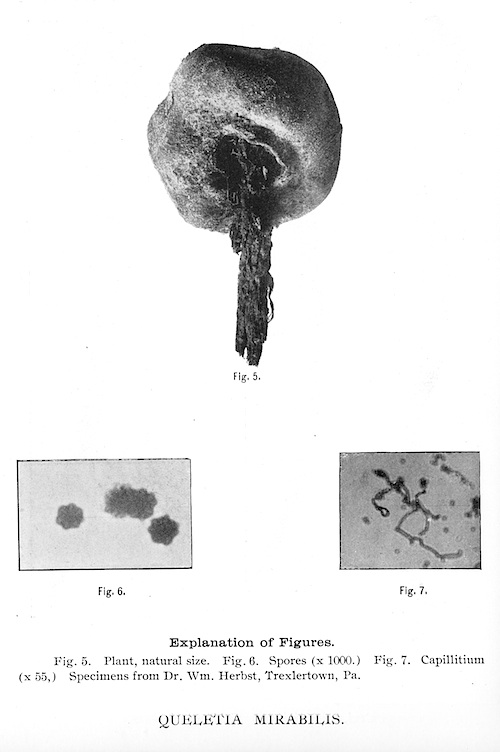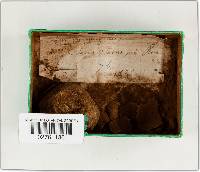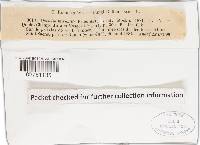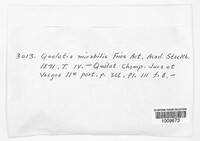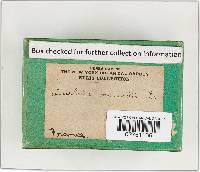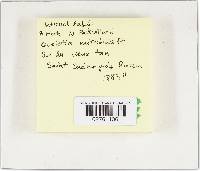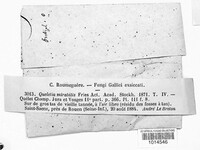
|
|
|
|
Family: Agaricaceae
|
Pegler DN, Laessoe T, Spooner BM. 1995. British Puffballs Earthstars and Stinkhorns. Royal Botanic Gardens, Kew Queletia mirabilis Fr. in Ofvers Forh. Kl. Svenska Vetensk.-Akad. 28: 171, p1.4 (1871). Selected descriptions: Azema (1990: 21); Coker & Couch (1928: 158-159); Mornand (1989: 13); White (1901: 441). Selected illustrations: Cetto (1988: 380); Coker & Couch (1928: pl. 119 figs 16, 17); Dumée & Maire (1913: 501 figs 1-6; pl. XXVIII); Fischer (1900: fig. 180); Jülich (1983: pls 1-4 (spores)); Moravec (1958a: fig. 227); Mornand (1989: fig. 17); Ramsbottom (1953: pl. XII a, b); White (1901: pl. 38 figs 1-5). Diagnostic characters: stipe well-developed, fibrous-scaly; peristome absent; spores coarsely verruculose, 6-7.5 µm diam. (excluding ornament). Fruitbody at first sessile, subglobose or depressed, narrowed below, with sterile base, stipitate at maturity. Stipe 2.5-4.5 (-7) cm high, 0.5-1.5 (-2) cm diam., cylindric or tapered to apex, inserted into base of endoperidial body, dry, fibrous, surface splitting, scaly, whitish to pale brown. Exoperidium inconspicuous. Endoperidial body 2.5-4 (-5) cm diam., subglobose-depressed, somewhat ribbed below, irregularly lacerate or flared around stipe apex, dehiscing by irregular splitting and flaking of the endoperidium and easily separated from the stipe. Endoperidium scurfy or smooth, whitish to pale cream. Gleba pale brown, powdery at maturity. Capillitial hyphae mostly 5-9 µm diam., hyaline, simple or sparingly branched, undulate or irregularly coiled, tapered to rounded ends, 3-4.5 µm diam., thick-walled, with lumen distinct, sparsely septate, septa constricted, not pigmented, surface smooth or granulate. Basidiospores 5.6-7.5 µm diam. excl. orn., (7-) 7.5-9.5 µm diam. incl. orn., verruculae irregular, narowly conical or blunt, isolated or coalescent in small groups, 0.5-1.2 µm high, globose or subglobose, yellow-brown. Habitat: on old tanbark. Distribution and frequency: an alien species, known in Britain from only two collections (a).October 1893 from the Herbarium grounds, Kew, found on discarded debris of Pennsylvanian material; (b) from spent tan at Barnsbury, London, October 1941. Moreno G, Ribes MA, Escobio V, Khalid AN (2012) Mycotaxon 119: 89-94 Queletia mirabilis Fr., Öfvers. Förhandl. K. Svenska Vetensk.-Akad. 28: 171 (1872) Figs. 1-12 Basidiomata scattered to gregarious, stipitate. Pileus globose to subglobose, 3-4 cm in diam., 1.5-2 cm high. Peridium mostly missing, only near the base in contact with foot, composed of a membrane, 3-5 mm thick, with smooth, whitish outer surface; rough inner surface, irregular, brown to ochre, with abundant remains of capillitium and spores. Gleba ocher, abundant, with filaments of whitish capillitium. Dehiscence apical, irregular, without formation of a stoma or defined structure. Stipe 0.7-1.2 x 6-10 cm, cylindrical, curved, fading towards base, not twisted, with a strongly folded surface and appearing torn, ochre and brown, woody. Columella absent. Basidiospores yellow-ochraceous, globose to subglobose, (4.9-)5.4-6.6 (-7.8) x (4.4-)4.9-6.2(-6.8) μm, excluding ornamentation; Q = 1.0-1.2(-1.4), N = 94, I = 6.0 x 5.5 μm, Q = 1.1, with a prominent hilar appendix, strongly verrucose, with verrucae grouped into conical structures (0.8-)1.1-1.5(-1.7) μm, N = 52, I = 1.3 μm high. Basidia not seen. Capillitium abundant, cylindrical, twisted, wavy-helical without fibulae, ocher, thick-walled, poorly branched and rarely septate, that breaks easily, probably as a result of handling (4.4-)5.6-8.9(-10.3) μm, I = 7.1 μm wide. SEM revealed spore ornamentation consisting of long rods that join together to form pyramidal structures. This type of spore ornamentation matches Q. mirabilis from France deposited at PC (Jülich 1983). Other material studied: Queletia andina —Argentina, Mendoza, San MartÃn, leg. J. Semper, 15-VII-1950, Ruiz Leal 16204 (holotype, BAFC 28711;, isotype, AH 39332). Queletia mundkurii —Pakistan, Punjab, Ladhar, on ground, 18-VIII- 1947, LAH, duplicate in AH 39333. |
|
|
|

